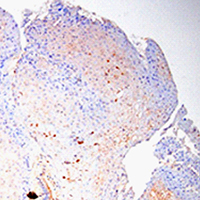HPV infection upregulates the expression of ZNT-1 in condyloma acuminatum

Submitted: 14 February 2021
Accepted: 13 April 2021
Published: 28 April 2021
Accepted: 13 April 2021
Abstract Views: 980
PDF: 510
HTML: 10
HTML: 10
Publisher's note
All claims expressed in this article are solely those of the authors and do not necessarily represent those of their affiliated organizations, or those of the publisher, the editors and the reviewers. Any product that may be evaluated in this article or claim that may be made by its manufacturer is not guaranteed or endorsed by the publisher.
All claims expressed in this article are solely those of the authors and do not necessarily represent those of their affiliated organizations, or those of the publisher, the editors and the reviewers. Any product that may be evaluated in this article or claim that may be made by its manufacturer is not guaranteed or endorsed by the publisher.
Similar Articles
- Qingwen Li, Jiao Zhang, Shougang Liu, Fangfei Zhang, Jiayi Zhuang, Yongfeng Chen, MicroRNA-17-3p is upregulated in psoriasis and regulates keratinocyte hyperproliferation and pro-inflammatory cytokine secretion by targeting CTR9 , European Journal of Histochemistry: Vol. 66 No. 1 (2022)
- G. Natale, E. Pompili, F. Biagioni, S. Paparelli, P. Lenzi, F. Fornai, Histochemical approaches to assess cell-to-cell transmission of misfolded proteins in neurodegenerative diseases , European Journal of Histochemistry: Vol. 57 No. 1 (2013)
- T. Kato, K. Oka, T. Nakamura, A. Ito, Decreased expression of Met during differentiation in rat lung , European Journal of Histochemistry: Vol. 60 No. 1 (2016)
- Liying Shen, Kongjie Lu, Zhenfeng Chen, Yingwei Zhu, Cong Zhang, Li Zhang, Pre-treatment with galectin-1 attenuates lipopolysaccharide-induced myocarditis by regulating the Nrf2 pathway , European Journal of Histochemistry: Vol. 67 No. 4 (2023)
- G. Tomasello, C. Sciumé, F. Rappa, V. Rodolico, M. Zerilli, A. Martorana, G. Cicero, R. De Luca, P. Damiani, F.M. Accardo, M. Romeo, F. Farina, G. Bonaventura, G. Modica, G. Zummo, E. Conway de Macario, A.J.L. Macario, F. Cappello, Hsp10, Hsp70, and Hsp90 immunohistochemical levels change in ulcerative colitis after therapy , European Journal of Histochemistry: Vol. 55 No. 4 (2011)
- E. Akat, H. Arıkan, B. Göçmen, Histochemical and biometric study of the gastrointestinal system of Hyla orientalis (Bedriaga, 1890) (Anura, Hylidae) , European Journal of Histochemistry: Vol. 58 No. 4 (2014)
- Mohammed Akeel, Ahmed Elhafey , Atef Shehata , Erwa Elmakki , Thanaa Aboshouk, Hussein Ageely , Mohammed Salih Mahfouz , Efficacy of immunohistochemical staining in detecting Helicobacter pylori in Saudi patients with minimal and atypical infection , European Journal of Histochemistry: Vol. 65 No. 3 (2021)
- Zhi Wang, Guihua Jian, Teng Chen, Yiping Chen, Junhui Li, Niansong Wang, The Qi-Bang-Yi-Shen formula ameliorates renal dysfunction and fibrosis in rats with diabetic kidney disease via regulating PI3K/AKT, ERK and PPARγ signaling pathways , European Journal of Histochemistry: Vol. 67 No. 1 (2023)
- H.G. Xu, W. Zhang, Q. Zheng, Y.F. Yu, L.F. Deng, H. Wang, P. Liu, M. Zhang, Investigating conversion of endplate chondrocytes induced by intermittent cyclic mechanical unconfined compression in three-dimensional cultures , European Journal of Histochemistry: Vol. 58 No. 3 (2014)
- Yin Pan, Di Qiu, Shu Chen, Xiaoxue Han, Ruiman Li, High glucose inhibits neural differentiation by excessive autophagy via peroxisome proliferator-activated receptor gamma , European Journal of Histochemistry: Vol. 67 No. 2 (2023)
<< < 28 29 30 31 32 33 34 35 36 37 > >>
You may also start an advanced similarity search for this article.

 https://doi.org/10.4081/ejh.2021.3228
https://doi.org/10.4081/ejh.2021.3228










